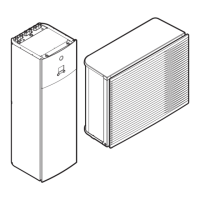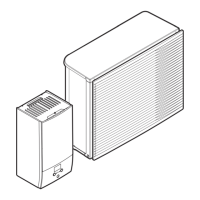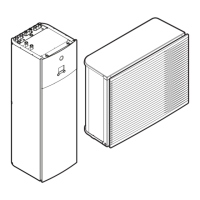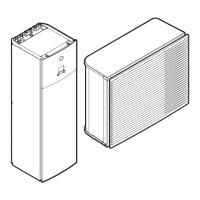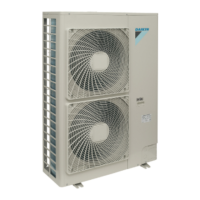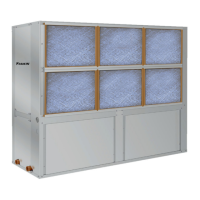What to do if Daikin EPRA12EAW1 Heat Pump is not heating or cooling as expected?
- PPatricia DelgadoAug 9, 2025
If your Daikin Heat Pump isn't heating or cooling as expected, it is recommended to contact your installer for assistance.
What to do if Daikin EPRA12EAW1 Heat Pump is not heating or cooling as expected?
If your Daikin Heat Pump isn't heating or cooling as expected, it is recommended to contact your installer for assistance.
What to do if Daikin EPRA12EAW1 Heat Pump compressor does not start?
If the compressor in your Daikin Heat Pump isn't starting for space or domestic water heating, it is recommended to contact your installer.
What to do if Daikin Heat Pump tank disinfection function is not completed correctly?
If the tank disinfection function on your Daikin Heat Pump is not completing correctly (AH-error), it is recommended to contact your installer.
Outlines critical safety guidelines and precautions for installers to follow during unit installation and handling.
Outlines crucial safety measures for electrical connections, preventing shocks and hazards.
Detailed safety instructions for all aspects of electrical installation, wiring, and components.
Guides the user on setting up the system for space heating and cooling based on room requirements.
Guides on setting up systems with two leaving water temperature zones for rooms with different heating/cooling needs.
Explains how to set up an auxiliary heat source, like a boiler, for space heating in bivalent systems.
Guides on determining DHW consumption, selecting tank volume, and setting desired temperatures.
Explains how to install and configure DHW pumps for instant hot water and disinfection.
Describes how the system measures and displays energy data like produced heat and consumed energy.
Describes methods to limit power consumption, including permanent limitation and digital inputs.
Covers the selection of an appropriate installation location with sufficient space and avoidance of dust.
Details the specific requirements for the installation site of the outdoor unit, including general safety precautions.
Guidance on ensuring the installation ground is strong and level, and securely fixing the unit.
Step-by-step instructions for carrying and fixing the outdoor unit onto the installation structure.
Ensures proper drainage of condensation water, avoiding ice accumulation and slippery conditions.
Outlines the typical workflow and precautions for mounting the indoor unit.
Detailed instructions for connecting the domestic hot water piping, including expansion vessel and tundish.
Explains methods for protecting the water circuit from freezing, including glycol and freeze protection valves.
Introduces the process of connecting electrical wiring and general precautions.
Highlights critical safety precautions for electrical wiring connections, emphasizing risk of electrocution.
Provides an overview of electrical connections for the outdoor unit.
Step-by-step instructions for connecting electrical wiring to the outdoor unit's switch box.
Details various connections to the indoor unit, including power, control, and optional modules.
Step-by-step instructions for connecting the main power supply to the indoor unit.
Details on connecting the power supply for the backup heater, considering different models.
Describes the initial setup process guided by the configuration wizard upon first power-on.
Covers settings for the main zone, including emitter type, control, and setpoint ranges.
Covers settings for an additional zone, including schedule, setpoint mode, and WD curves.
Covers settings related to space heating and cooling operation modes, ranges, and pumps.
Covers user-configurable settings like language, time/date, holiday, and quiet mode.
Contains settings specifically for installers, including configuration wizard and domestic hot water setup.
Highlights critical precautions and information to consider before starting the commissioning process.
Provides a checklist of essential items to verify after installation and before unit power-up.
Outlines checks to perform during the commissioning phase, including flow rate and air purge.
Explains the purpose and procedures for performing manual and automatic air purging of the water circuit.
Guides on performing test runs for heating, cooling, and tank operation to verify system functionality.
Explains the function and programming of the UFH screed dryout schedule for new installations.
Highlights essential safety precautions to be taken before performing any maintenance or service work.
Details the yearly maintenance procedures for the outdoor unit, including heat exchanger and filter cleaning.
Step-by-step instructions for safely draining the domestic hot water tank.
Procedures for inspecting the interior of the domestic hot water tank, potentially using an endoscope.
Essential safety precautions to follow when troubleshooting, emphasizing disconnection from power.
Guides on identifying and resolving common operational problems based on observed symptoms.
Guides on how to display and understand error codes for system malfunctions.
Provides an overview of common error codes and their corresponding descriptions for unit malfunctions.
Procedures for recovering refrigerant from the outdoor unit before disposal, complying with legislation.
Illustrates the wiring connections for the outdoor unit, including component identification and symbols.
Illustrates the wiring connections for the indoor unit, including terminal points and optional parts.
Provides technical specifications for the domestic hot water tank, including capacity and reheat times.
Outlines critical safety guidelines and precautions for installers to follow during unit installation and handling.
Outlines crucial safety measures for electrical connections, preventing shocks and hazards.
Detailed safety instructions for all aspects of electrical installation, wiring, and components.
Guides the user on setting up the system for space heating and cooling based on room requirements.
Guides on setting up systems with two leaving water temperature zones for rooms with different heating/cooling needs.
Explains how to set up an auxiliary heat source, like a boiler, for space heating in bivalent systems.
Guides on determining DHW consumption, selecting tank volume, and setting desired temperatures.
Explains how to install and configure DHW pumps for instant hot water and disinfection.
Describes how the system measures and displays energy data like produced heat and consumed energy.
Describes methods to limit power consumption, including permanent limitation and digital inputs.
Covers the selection of an appropriate installation location with sufficient space and avoidance of dust.
Details the specific requirements for the installation site of the outdoor unit, including general safety precautions.
Guidance on ensuring the installation ground is strong and level, and securely fixing the unit.
Step-by-step instructions for carrying and fixing the outdoor unit onto the installation structure.
Ensures proper drainage of condensation water, avoiding ice accumulation and slippery conditions.
Outlines the typical workflow and precautions for mounting the indoor unit.
Detailed instructions for connecting the domestic hot water piping, including expansion vessel and tundish.
Explains methods for protecting the water circuit from freezing, including glycol and freeze protection valves.
Introduces the process of connecting electrical wiring and general precautions.
Highlights critical safety precautions for electrical wiring connections, emphasizing risk of electrocution.
Provides an overview of electrical connections for the outdoor unit.
Step-by-step instructions for connecting electrical wiring to the outdoor unit's switch box.
Details various connections to the indoor unit, including power, control, and optional modules.
Step-by-step instructions for connecting the main power supply to the indoor unit.
Details on connecting the power supply for the backup heater, considering different models.
Describes the initial setup process guided by the configuration wizard upon first power-on.
Covers settings for the main zone, including emitter type, control, and setpoint ranges.
Covers settings for an additional zone, including schedule, setpoint mode, and WD curves.
Covers settings related to space heating and cooling operation modes, ranges, and pumps.
Covers user-configurable settings like language, time/date, holiday, and quiet mode.
Contains settings specifically for installers, including configuration wizard and domestic hot water setup.
Highlights critical precautions and information to consider before starting the commissioning process.
Provides a checklist of essential items to verify after installation and before unit power-up.
Outlines checks to perform during the commissioning phase, including flow rate and air purge.
Explains the purpose and procedures for performing manual and automatic air purging of the water circuit.
Guides on performing test runs for heating, cooling, and tank operation to verify system functionality.
Explains the function and programming of the UFH screed dryout schedule for new installations.
Highlights essential safety precautions to be taken before performing any maintenance or service work.
Details the yearly maintenance procedures for the outdoor unit, including heat exchanger and filter cleaning.
Step-by-step instructions for safely draining the domestic hot water tank.
Procedures for inspecting the interior of the domestic hot water tank, potentially using an endoscope.
Essential safety precautions to follow when troubleshooting, emphasizing disconnection from power.
Guides on identifying and resolving common operational problems based on observed symptoms.
Guides on how to display and understand error codes for system malfunctions.
Provides an overview of common error codes and their corresponding descriptions for unit malfunctions.
Procedures for recovering refrigerant from the outdoor unit before disposal, complying with legislation.
Illustrates the wiring connections for the outdoor unit, including component identification and symbols.
Illustrates the wiring connections for the indoor unit, including terminal points and optional parts.
Provides technical specifications for the domestic hot water tank, including capacity and reheat times.
| Model | EPRA12EAW1 |
|---|---|
| Refrigerant | R32 |
| Power Supply | 220-240V, 50Hz |
| Noise Level (Outdoor) | 45 dB(A) |
| Operating Temperature Range (Heating) | -15°C to 24°C |
